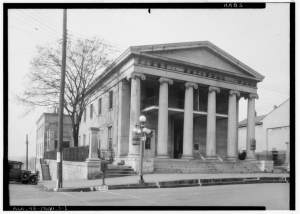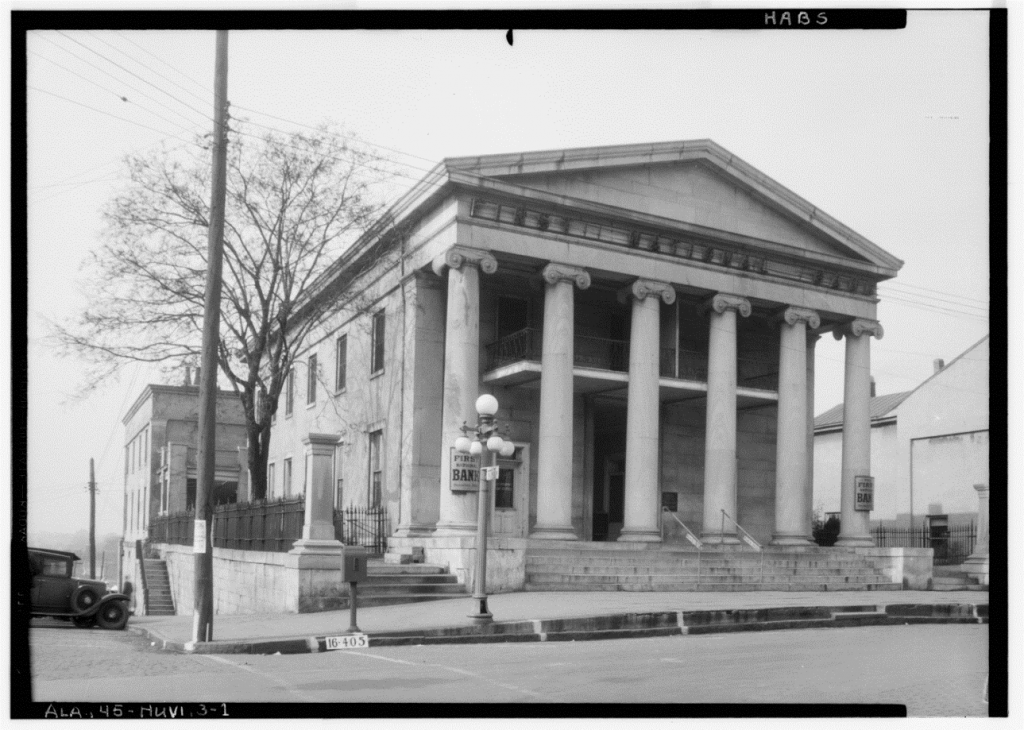Banking on History
Published on August 4, 2015

A Brief History of the First National Bank Building
The Branch of the Bank of the State of Alabama at Huntsville was established by the General Assembly on January 10, 1835. Despite the lack of a building to house the bank, the state appointed a board of directors to oversee the bank’s progress on January 9, 1835. According to several primary source supporting documents, the bank building on Westside Square was not constructed until after 1837, and was most likely completed by 1840.
The First National Bank building is a Greek Revival style building built in c. 1838 and designed by local architect George Gilliam Steele. The building features a limestone façade with Ionic order columns, a large set of wood pocket doors, wood panel side doors, and three second floor windows. The north, south, and west sides of the building are covered in stucco siding and feature wood windows with limestone lintels. A three story stucco clad wing on the back of the building was used as slave quarters, but has since been remodeled as supporting offices for the bank building. The entire building rests on a cut limestone block foundation, and stands atop the bluff overlooking Big Spring Park.
Shortly after the Branch Bank began the country experienced a large scale panic known as the Panic of 1837. Eventually the Branch of the Bank of the State of Alabama at Huntsville succumbed to the pressures of the Panic of 1837. By February 4, 1843, an Act passed by the General Assembly allowed for the liquidation of the Branch of the Bank of the State of Alabama at Huntsville. The bank building and land was sold in October of 1852 to the Northern Bank of Alabama.
Like the Branch of the Bank of the State of Alabama at Huntsville, the Northern Bank of Alabama was destined to face turmoil. On April 12th 1861, the American Civil War tore through the country marking the beginning of a tumultuous time in Huntsville. For most of the war Huntsville was occupied by the Union army. Several buildings and homes in Huntsville were used by the Union army, and were used primarily as headquarters and encampments. During the Civil War the Northern Bank of Alabama was used as the commissary for Union troops. Union occupation spared the bank building and many other buildings in Huntsville from the ravages of the Civil War.
Five months after the end of the Civil War on September 15, 1865, the National Bank of Huntsville was chartered. According to bank financial statements the National Bank of Huntsville began renting the bank building on October 1, 1865. By January 4, 1867, the National Bank purchased the bank building for the sum of $30,000.
Although Huntsville experienced a slight depression in the post-Civil War Reconstruction years, by the 1880s and 90s Huntsville experienced tremendous growth due to the establishment of the cotton mill industry. Due in large part to the enterprising assistance of men like Michael and James O’Shaughnessy, Tracy Pratt, William Wells, and Willard Wellman, Huntsville was able to quickly establish itself as a major milling town. The National Bank of Huntsville, along with the cotton mills, prospered during the late 19th and early 20th century.
On July 3, 1889, leadership at the National Bank chartered the First National Bank. In a deed dated July 5, 1889, the National Bank of Huntsville sold the bank house and property to the First National Bank for the sum of $20,000. It was under the management of the First National Bank that the bank building underwent several changes. By 1900, the First National Bank had added a second story balcony to the front of the building, cut in two office doors on the first floor, added two windows and a door on the second floor, and completed several interior alterations including the addition of molding and millwork remnants of which can still be seen today.
The prosperity brought on by the milling industry in Huntsville spurred on progress in the city for a time. By 1930, however, the whole of the nation had succumbed to the trauma inflicted by the Great Depression. Many of the local mills continued operating, providing Huntsvillians with more than 4,000 jobs. The milling industry proved to be unstable, however, facing labor unrest, strikes, and walkouts. Labor struggles would prove to be a continued issue into the late 1930s.
Added assistance from later New Deal initiatives like the Public Works Administration (PWA) and the Civilian Conservation Corps (CCC) also helped to support Huntsville during the Great Depression. One of the most important contributions of the New Deal to the city of Huntsville was the large scale documentation of several of Huntsville’s iconic historic buildings by the Historic American Building Survey (HABS). HABS reports were completed for the Weeden House , the LeRoy Pope mansion , the third county courthouse , and the National Bank building among others.
The entry of the United States into the World War II conflict in December of 1941 marked the beginning of a new era of progress in the city of Huntsville. In July 1941, Huntsville established the Huntsville Arsenal, a $40 million chemical war plant. The establishment of the Huntsville Arsenal and the presence of the U.S. military in the Huntsville would impact the city for decades to come.
The Arsenal helped to boost population growth which in turn spurred on the local economy. By the Wars end in the fall of 1945, however, the plants closed. By 1947, the Huntsville Arsenal was considered military surplus and was posted for sale. Fearing the collapse of Huntsville’s economy with the closure of the Arsenal, U.S. Senator John Sparkman worked with White House administration and the military to develop a new use for the Redstone Arsenal. Sparkman’s efforts proved fruitful and in October 1949 the army moved its Ordnance Research and Development Division Sub-Office for Rockets from Fort Bliss Texas to Huntsville.
The Arsenal in Huntsville helped to usher the United States into the space age in the 1950s when a team of German scientists, led by Wernher von Braun, arrived in Huntsville. The innovations introduced by the team of scientists and the prosperity that those advances cultivated within Huntsville’s economy launched a sharp growth in Huntsville’s population. In a span of 10 years the population more than quadrupled, jumping from 16,000 residents to 72,000 residents in the decade of the 1950s. The capstone of the city’s transformation was the jump in the average personal income, which surpassed the per capita income of the rest of Alabama by 20 percent in 1966.
With the transformation of the city’s economy came the transformation of the city’s landscape. Urban Renewal, spurred on by Huntsville’s desire to become more advanced, helped to reshape the downtown square. Huntsville demolished many of its historic downtown buildings to make way for modern architecture, most notably the removal of the third county courthouse and cotton row. While the First National Bank building was spared complete demolition, it did not fully escape the clutches of renewal.
Two major renovations to the First National Bank building took place in 1951 and 1967. During the 1951 renovations bank managers removed the original vault, demolished most of the second floor living quarters except for a small mezzanine area, installed marble in the lobby, removed the second floor balcony, replaced the second floor door on the façade with a window, and added two teller windows to the first floor of the rear wing (formerly slave holding cells). In 1967, the board of directors added one story executive offices to the north side of the bank, installed an elevator, added a secondary customer entrance to the bank on the south wall, expanded the rear wing of the structure, enclosed an open stairwell on the south side of the building, and added the weathervane from the top of the third Madison County courthouse. While these alterations were made to the bank at a much later time period, they are representative of an era of tremendous change in Huntsville and, therefore, aid in placing the building into the historic context of the mid-20 th century.
After the 1967 renovations the bank changed very little except in name. In 1971, the bank became the First Alabama Bancshares Inc., after the First National Bank of Huntsville, the First National Bank of Montgomery, and the Exchange Security Bank of Birmingham partnered to form the new bank corporation. By 1994, Alabama Bancshares Inc. became Regions Financial Corporation. In 2010, Regions Financial Corporation donated the bank property to Big Spring Partners, and in 2014, a lease agreement between Big Spring Partners and Robert Broadway was created.
Since its construction in the early half of the 19th century, the First National Bank building has seen many changes to itself and its city. This building has witnessed and endured many of the same struggles and successes experienced by the city, state, and country as a whole for more than 175 years. The building, as ever, remains a vital part of historic downtown Huntsville, representing both traditional significance and modern progress, a bastion of Huntsville history.


